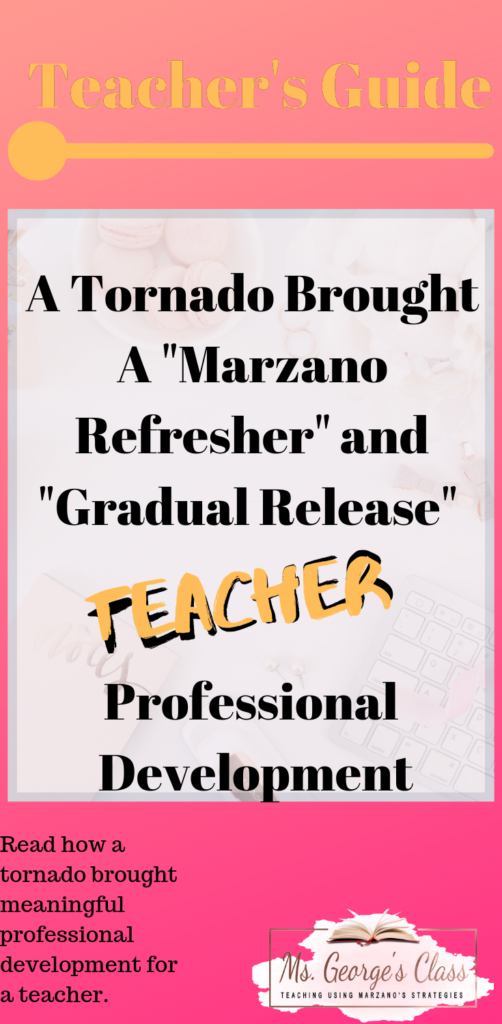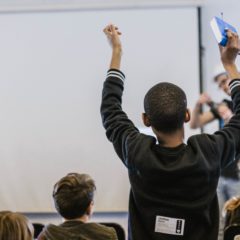
The night of Memorial Day 2019 changed my life. During the middle of the night, my cell phone chimed a weather alarm-a tornado was heading towards my neighborhood. My daughter and I quickly entered the laundry room and waited for the storm to pass. We heard a gust of wind overhead, and I knew that our time was limited. I called my mother and my ex-husband, and we prayed. Moments later, we walked outside our condominium and saw our neighbors assessing the damage. Our whole community was damaged. Roofs were torn off, two condominiums had lost a brick wall, and countless windows were broken. My condominium had minimum damage that was limited to the patio fence and shingles missing from the roof. In addition to the damage, there was no electricity or water. My daughter and I lived with my mother for nine days. We were very thankful for her support, but there is nothing like home. Our lives were saved, but we had to continue to live. One commitment I made was to attend the summer professional development.

The week of the tornado, I attended two professional developments on the topics of Marzano strategies and gradual release. The “Marzano Refresher” was a full day session taught by my school’s teacher leader. She politely acknowledged me and informed me that she would cover the same topics she covered during the school year. I was completely comfortable with it because I wanted to remain current on Marzano’s strategies that the school district supported. The “Gradual Release” professional development was a half-day session taught by a teacher from a school from out West. Her information was insightful and very useful. The presenter discussed the “I do, We do, You do” lesson preparation and how to make students more accountable for their learning.
The Marzano Refresher
The “Marzano Refresher” session began with each teacher getting a small cup of M and M’s candy. Each color had a specific celebration of success we had to discuss within our teacher groups. This activity was an icebreaker and provided the session with a positive mood. At my table, there were three teachers, and we shared our accomplishments with bright smiles. Some of the statements were “[name] one successful thing you are proud of in your classroom this year” and “one thing you appreciate about your colleague.” Each table shared one or two items, and then we moved on with the lesson. On another positive note, we did not remain in our groups. The facilitator used color-coded stickers on our folders and alphabets to transform groups. This was a great way to group students (another Marzano strategy).
Clear Learning Goals
The first lesson that was taught was “providing clear learning goals”. The facilitator began with a Google Slides Presentation. She posted a statement about Marzano and Gradual Release and posed two answers, true or false. On the following slide, she gave a brief description of both topics and emphasized that Marzano encompasses gradual release. We were instructed, within our groups, to identify 20 learning targets under the categories of effective, somewhat effective, and ineffective learning targets. The learning targets were statements that teachers used within their classrooms. This activity was challenging because we discussed whether the statement used an action word and if the wording was specific to the learning. In our folders, we had several worksheets that covered the topics that were going to be taught. Two worksheets were titled, “Guide for Effective Learning Targets”. These two worksheets were very helpful because they gave examples of effective and ineffective learning targets. For example, an ineffective learning target would be: “I can write a newspaper article.” An effective learning target would be: “I can add details to a feature article.”
When writing learning goals, focus on the standard, make it student- friendly, and use measurable objectives. The facilitator discussed focusing on one goal and avoiding using the conjunction ‘and’. For instance, what is to be learned? In my case, I teach language arts concepts. How do students show me they have learned the concepts? Most times, it is through writing, speaking, or some form of demonstration. Beginning your learning targets with statements such as “I can explain, “I can identify,” “I can describe” is a great start. However, you have to include specific and measurable objectives after the “I can” statement. Here’s another example of a somewhat ineffective learning goal: “I can identify characters, setting, and plot” versus “I can describe how early pioneers met the challenges of frontier life.” Increasing the rigor of the verb from identify to describe and stating the specific topic makes the second statement clearer.
In addition to “providing clear learning goals,” the facilitator discussed “establishing routines and procedures” and “setting high expectations for all students”. The presentation included charts for “What Works Best in Raising Student Achievement?” and “EDI Activations” (teacher efficacy). As a group, we discussed why it is important to include routines and procedures and how students feel safe in environments where rules are respected. The facilitator included a slide that was titled, “Strong Start”, and on this slide, there were several suggestions on how to increase efficiency at the beginning of the class. A few suggestions were to have students pick up work while entering the classroom and to narrate aloud the students who are showing the productive behaviors you want. During the “setting high expectations for all students” section, the facilitator introduced the book Teach Like a Champion 2.0 by Doug Lemov. Several learning strategies were listed and supported Marzano’s elements. One strategy that was discussed was the read, write, discuss, and revise strategy. This strategy includes reading a passage, writing your thoughts or answering a question, then discussing your answer with a classmate and revising your answering. The facilitator guided the teachers to complete the strategy using an article from Doug Lemov’s book.
Qualities of Accomplished Teaching
The last section of the presentation was titled, “What Does Accomplished Teaching Look Like?” Within our groups, we had to write on sticky notes our expectation of an accomplished teacher. Most teachers stated good classroom management, understanding of the standards, and keeping students engaged. Afterward, we deconstructed the Ohio Teacher Evaluation System and aligned it with Marzano’s model. You can visit my blog, where I deconstructed the Ohio Teacher Evaluation System here. We also reviewed the “Gradual Release & OTES” worksheet, where it stated more information about the differences in lesson delivery being evaluated as skilled and accomplished teachers. Many teachers had personal comments and questions about the current evaluation system. However, the facilitator listened to the concerns and reviewed how one can use the strategies mentioned to earn higher scores on their evaluation. I was engaged during this section too because I feel I can always improve in an area.
Gradual Release Model
“The Gradual Release” professional development was a half-day session, but the information was so rich and helpful that it should have been a full-day session. The facilitator, a former curriculum specialist returning to a high school ELA class, did an excellent job discussing the topic. She mentioned two books teachers should read: Visible Learning by John Hattie and They Say, I Say by Cathy Birkenstein and Gerald Graff. She gathered her research from these two books and encouraged us to read them.

The facilitator stated that it is the teacher’s responsibility to present the information, but it is the student’s responsibility to complete the assignment and be accountable for their own learning. Teachers and students should reflect on these questions: What am I learning today? Why am I learning this? How will I know that I have learned this? As teachers, we need to look at the content of the lesson. For example, students will learn, understand, or identify what concepts? How will they gain this information? What language will be used-formal, informal, casual, student-friendly? This strategy will give more accountability to students to learn the concept that is clear and concise.
We Do Strategy
A great deal of the session focused on guided instruction. My district considers guided instruction as a “we do” strategy. The facilitator stated the teacher is observing, assessing, offering, and suggesting but not giving answers. During guided instruction, it is a time for immediate intervention. Students are doing the work, not the teacher. The teacher uses the phrase, “take a look,” or “notice paragraph 2; what does this suggest?” She also included using sentence frames to assist students in their writing and completing think-alouds. Both strategies were heavily suggested at the Ohio Council of Teachers of English and Language Arts. As a final activity, the facilitator directed us to take one content standard and deconstruct it using the question, “What can be accomplished today?” Each teacher wrote one content standard and a content objective using an “I can” statement. One example of an I can statement was, “I can cite textual evidence to support an analysis of the short story ‘The Necklace’.” Next, we wrote a language objective that included “I will justify” or “I can identify” a specific assignment such as a passage. Finally, we wrote a social objective that included “sharing with a partner” or “explaining to a group.” The focus was to take the content standard and make three student-friendly objectives that guide students to complete a learning task successfully.
Professional development assists teachers to remain current, learn new innovations in education, and create ideas to be successful. The “Marzano Refresher” was most useful with deconstructing the learning goal and identifying the Marzano strategy with the teacher evaluation system. I enjoyed the “Gradual Release” session also. It supported more students taking accountability for their learning, while the teacher is an observer offering support when needed. As I am reading more professional books, I am learning that students working out problems helps them become independent thinkers. Teachers are to guide students, but the goal should be for students to show and explain their knowledge.




Leave a Reply